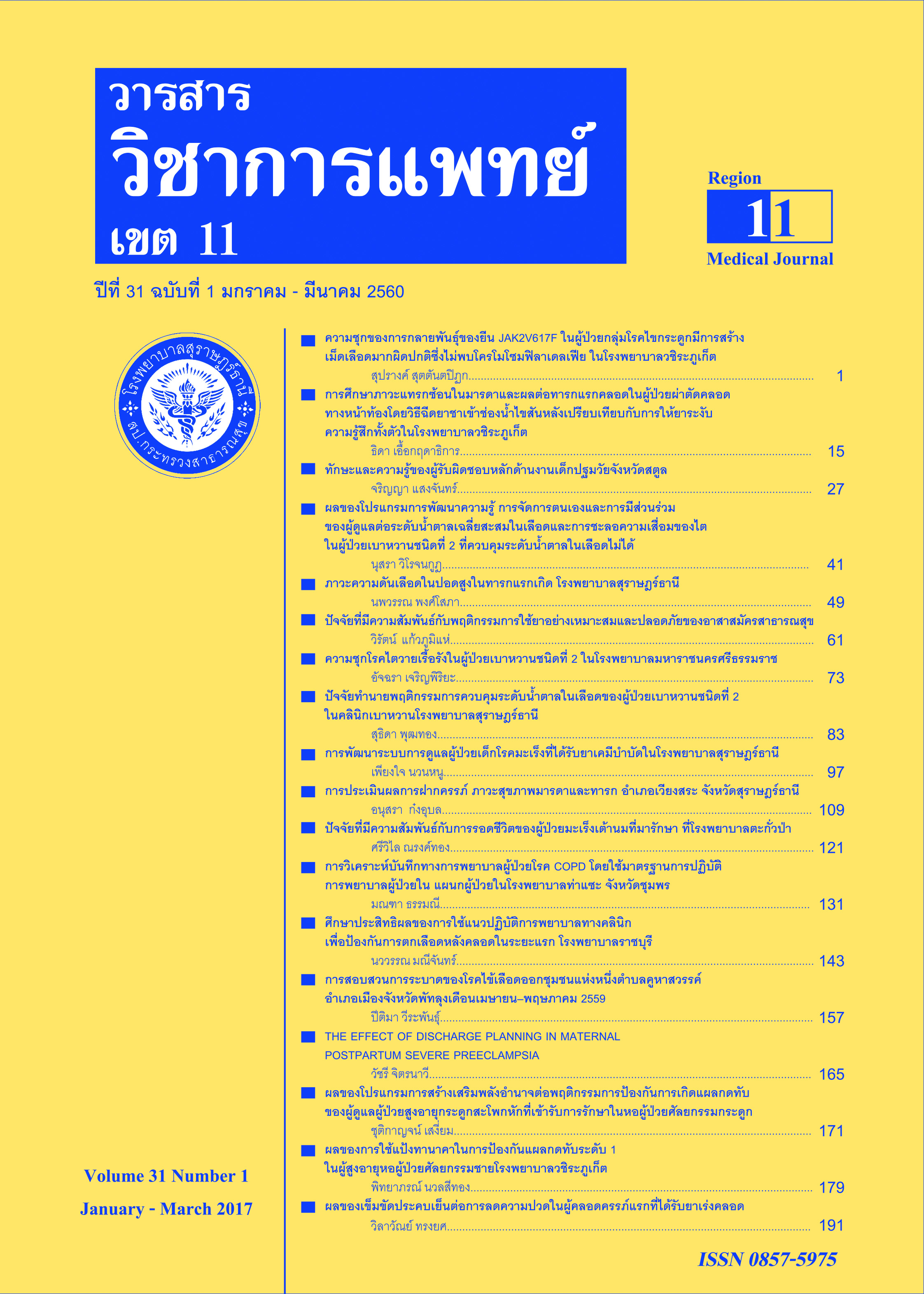Development of a Care Systemfor Pediatric Cancer Patients undergoing Chemotherapy in Suratthani Hospital
Keywords:
development, care system, pediatric cancer patient, chemotherapyAbstract
Aim of this action research were: to develop a care system for pediatric cancer patients undergoing chemotherapy at Suratthani Hospital and to evaluate outcomes. Three phases were 1) situation analysis on care for pediatric cancer patients at Suratthani Hospital; 2) development and operation of a care system for pediatric cancer patients; and 3) evaluation. Data collection: Phase I, 12 members of a multidisciplinary team joined a focus group discussion. Phase II, planning and operating of a care system based on a P-D-C-A model which were:1) Plan: enhancing nurses ability in Suratthani Hospital and a hospital
network; 2) Do: developing on a care system for pediatric cancer patients undergoing chemotherapy; establishing a CNPG running by a nurse case manager; 3) Check: piloting a developed care system in Suratthani hospital; and 4) Act: operating of a care system for pediatric cancer patients undergoing chemotherapy in Suratthani Hospital and a hospital network.Phase III, evaluation of 3 outcomes: 1) stakeholders:a multidisciplinary team, pediatric
cancer patients, and caregivers; 2) average length of stay; and 3) average hospital cost. Instruments were: 1) guiding questions for a focus group and interview, 2) an observation record on a care system adherence and satisfaction, 3) thePedsQL; 4) an adverse effect of chemotherapy record form; 5) a LOS, and hospital cost record form. Data analysis were a content analysis for qualitative data; and mathematic mean, standard deviation, and percent for
quantitative data.
Findings were 1) stackholders: 37 members of a multidisciplinary team adhered and satisfied on a developed care was 86% with positive reflection. Ninety pediatric cancer patients undergoing chemotherapy reported a higher level as compared with a previous study (75.63 ±2.81and 64.5±14). However, incidence of febrile neutropenia , and a grade III of mucositis were 8.49% and 5.23%; respectively. Caregivers' satisfaction was a high level of 86.78%. Average LOS was shorter than preoperational stage (13days and 9 days). Average hospital cost was lower than preoperational stage (40,056baht and 28,300baht).
Results of this study indicated that a care system for pediatric cancer patients undergoing chemotherapy enchaining a good service. However, the opportunity for improvement was reducing of an adverse effect of chemotherapy. Next step was Act to distribute this care system to a network hospital.
References
2. นิลทิตา ศรีไพบูลย์กิจ.การศึกษาอัตราการรอดชีพของผู้ป่วยมะเร็งเด็กไทย วิทยานิพนธ์คณะสาธารณสุขศาสตร์ บัณฑิตวิทยาลัย มหาวิทยาลัยขอนแก่น;2552.
3. โรงพยาบาลสุราษฎร์ธานี. รายงานสถิติผู้ป่วยเด็กโรคมะเร็ง;2559.
4. สำนักบริหารการสาธารณสุข สำนักงานปลัดกระทรวงสาธารณสุข. แนวทางพัฒนาระบบบริการสุขภาพสาขาโรคมะเร็ง. พิมพ์ครั้งที่1 กรุงเทพมหานคร:ชุมนุมสหกรณ์การเกษตรแห่งประเทศไทย;2556
5. ธมนพัชร์ สิมากร. การจัดการผู้ป่วยรายกรณี (Case management). เอกสารประกอบการบรรยายในการประชุมวิชาการก้าวไกลทางการพยาบาลออร์โธปิดิกส์;24 – 25 กุมภาพันธ์ 2554 ; โรงแรมปริ้นพาเลซ กรุงเทพมหานคร : ชมรมพยาบาลออร์โธปิดิกส์ แห่งประเทศไทย;2554.
6. ศิริวันต์ ยิ้มเลี้ยง. การพัฒนารูปแบบการดูแลผู้ป่วยโดยประยุกต์ใช้ระบบการจัดการรายกรณี โรงพยาบาลพิจิตร. วารสารกองการพยาบาล ; 2554 : 52 -66.
7. กาญจนา อุบลพงศ์และคณะ. การพัฒนารูปแบบบริการพยาบาลผู้ป่วยมะเร็งลำไส้ใหญ่ที่ผ่าตัดเปิดทวารเทียมโรงพยาบาลสระบุรี. วารสารกองการพยาบาล;2555: 51-64.
8. Kermis S, McTaggart R. The action research planner. 3rd ed. Geelong: Dekin University Press;1998.
9. Hayajneh Y. Management for Health Care Professionals Series Systems & Systems Theory. Available from: http://www.theinformatician.com/yaseen ; 2007.
10. แนวคิดคุณภาพ HA. Available from:http://www. med.cmu.ac.th.[ออนไลน์].แหล่งที่มา:http://bps.moph.go.th.[สืบค้นเมื่อวันที 12 กันยายน 2559].
11. สถาบันมะเร็งแห่งชาติ กรมการแพทย์ กระทรวงสาธารณสุข. นิยามตัวชี้วัด Service Planสาขาโรคมะเร็ง.กรุงเทพมหานคร;2558.
12. Varni JW, Seid M, Rode CA. The PedsQL 4.0 : measurement model for the pediatric quality of life inventory. Med Care ;1999 : 37 : 126 – 39.
13. Varni JW, Seid M, Kurtin PS. PedsQL 4.0 : reliability and validity of the Pediatric Quality of Life Inventory version 4.0 generic core scales in healthy and patient populations. Med Care ;2001 : 39 : 800-12.
14. Varni JW, Seid M Kinght TS, et al. The PedsQL 4.0 Generic Core Scales : sensitivity, responsiveness and impact on clinical decision – making. J Behav Med ; 2002 : 25 : 175 – 93.
15. Varni JW, Bruwinkle TM, Seid M. The PedsQL 4.0 as pediatric population health measure : feasibility, reliability population health measure : feasibility reliability and validity Ambul Pediatr ;2003 : 3 : 329 – 41.
16. จุรีภรณ์ พุ่มสีทอง. คุณภาพชีวิตด้านสุขภาพของผู้ป่วยเด็กโรคเรื้อรัง ที่โรงพยาบาลธรรมศาสตร์เฉลิมพระเกียรติ. ภาควิชากุมารเวชศาสตร์ คณะแพทยศาสตร์ มหาวิทยาลัยธรรมศาสตร์; 2553.
17. วิไลวรรณ โพธิ์ศรีทอง และคณะ. การพัฒนาระบบการดูแลผู้ป่วยเบาหวานด้วยรูปแบบการจัดการรายกรณีโรงพยาบาลสระบุรี . วารสารกองการพยาบาล ;2555 : 2 : 79 - 93






